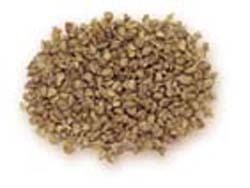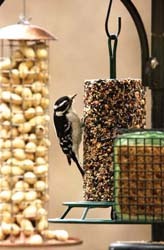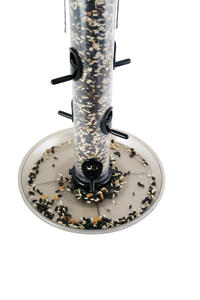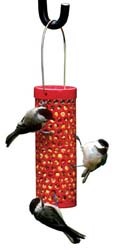No Mess Birdfeeding
Many of the uninitiated equate birdfeeding with offering seed, and equate offering seed with offering large quantities of filler-packed discount blends, and equate those wasteful seed blends with unsightly messes and rodent attraction.
Bird feeding does not have to be this way.
Read below to learn about both ways to make seed feeding cleaner and cleaner alternatives to seed.
Clean up your seed feeding
Avoid bad seed blends
The leading cause of "messy seed" complaints is the use of low-quality seed blends. Many mass market seed blends sold in grocery, hardware, and pet stores contain filler or near-filler grains such as milo, wheat, sorghum, or anonymous "grain products" which appeal to few birds beyond doves and pigeons. They also often contain extremely high proportions of millet (small, round, light colored) to sunflower (larger and black); while millet is attractive to several ground feeding birds, most perching songbirds will toss millet to the ground as they select the sunflower seeds and other more desirable ingredients in a blend. Our seed blends contain no fillers and are formulated to attract the birds you want. As a general rule, look for blends with a high percentage of black oil sunflower.
No-Mess Seed Blends
Even good, attractive seeds such as sunflower or safflower will leave shells behind. Some birds will also toss smaller seeds aside when deciding whether a seed is worth the effort of cracking open. You can solve both of these causes of mess by using one of our No-Mess Seed Blends.
Seed Cylinders
Seed cylinders use many of the same ingredients as found in our seed blends, but stick the seeds together with gelatin in a compact, hand molded cylinder. Since each seed needs to be worked off individually, much less falls to the ground.
Read more and see pictures and video on our Cylinders Page.
Feeder selection and accessories
Trays: Our general seed and finch tube feeders can be accessorized with trays that screw easily and securely directly to the feeder base to reduce spilled seed. If you have a Wild Birds Unlimited or Aspects brand tube feeder, you can use a tray like this one. Visit our store for trays from other feeder brands.
Finch Feeders: Mesh socks are messy. A specialized finch tube feeder has small ports to prevent the spilling of Nyjer (thistle) seed.
Selective Feeding: Squirrels, racoons, and larger birds can upset feeders and cause mess. Making your feeding station squirrel-proof and innaccesible to larger birds will result in a cleaner bird feeding experience. Visit our Defeating Squirrels page for more information.
Alternatives to Seed
Bark Butter
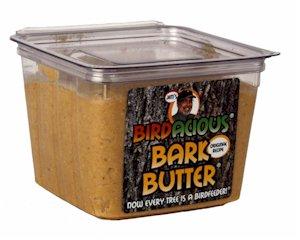 Our exclusive Bark Butter is a spreadable, peanut-flavored suet dough. Everything is edible: there are no shells or sprouting seeds. It will maintain its consistency well into the 90s before getting at all gooey, and it will take extremely high heat to cause any dripping. Bark Butter is superior to traditional suet cakes for a few reasons:
Our exclusive Bark Butter is a spreadable, peanut-flavored suet dough. Everything is edible: there are no shells or sprouting seeds. It will maintain its consistency well into the 90s before getting at all gooey, and it will take extremely high heat to cause any dripping. Bark Butter is superior to traditional suet cakes for a few reasons:
- Spread it anywhere. You want the birds to enjoy their meal over by those trees? Just spread it on the tree branches. Alternatively, use any of our wide variety of feeders: big, small, recycled, natural found wood.
- Easier to use: getting those suet cakes out of their packaging and into their feeders can be a gooey proposition, especially since some unmixed suets have
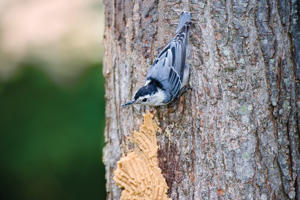 lower melting points than Bark Butter. Bark Butter comes in easy to open and close tubs; all you need is a fork or other spreading device and you can easily put exactly how much you want, where you want it.
lower melting points than Bark Butter. Bark Butter comes in easy to open and close tubs; all you need is a fork or other spreading device and you can easily put exactly how much you want, where you want it. - Attract more birds: Bark Butter has attracted over 130 species of birds and the list keeps growing. Part of this is due to the flexibiliy it offers; putting it right on the trees where shyer species stay hidden may attract birds that are sometimes reluctant to come to feeders. But a main reason is simply because Bark Butter is a delicious and energy-rich food.
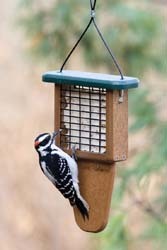 Suet
Suet
Suet offers many of the advantages of Bark Butter: a popular food with no shells or sprouting seeds. Available as cakes or cylinders, they are easy to refill, although specialized feeders are generally needed. (Simple cages or hanging pins start at just a few dollars; feeding suet requires a very low opening investment.) Many of your favorite seed eating birds, such as chickadees, titmice, and nuthatches will also eat suet, and so will woodpeckers, fascinating birds who are generally less attracted to seed feeders. Read more about suet here.
Peanuts
Shelled peanuts can be quite a clean option, with no shells and no sprouting. Jays, woodpeckers, chickadees, titmice, and nuthatches will happily eat peanuts. Offer in a mesh feeder or open tray. There are even squirrel-proof peanut feeders. Learn more about the joys of peanut feeding.
Hummingbirds
If you're not already feeding hummingbirds, you should start. They are common and easy to attract, while sugar water feeders leaves no mess and attract none of the larger pest animals (ants and bees - neither of which are neccesary consequences of hummingbird feeding - can be easily denied access with our hummingbird feeders). To learn how to keep your hummingbird feeding neat and effective, read our Attracting Hummingbirds.


